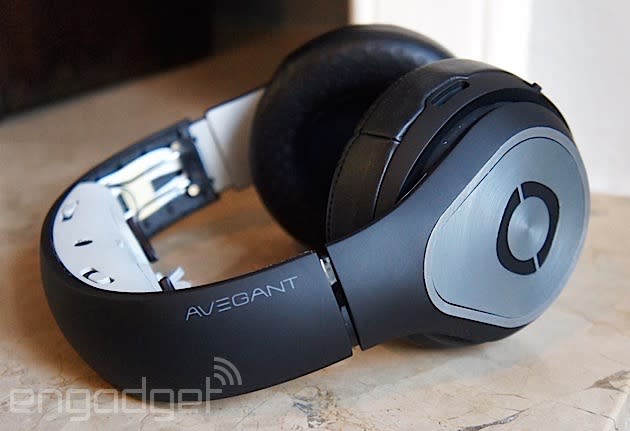Avegant's Glyph video headset will change how you see movies

Some products have a hard time ever getting to market. Some (seem to) come out of nowhere. Then there's the Avegant Glyph video headset. It initially launched on Kickstarter back in January 2014 (raising a cool $1.5-million). Along the way we've seen a ropey prototype. And then a less ropey one. And an even less ropey one. Today, we got to try out the nearest thing to the consumer product we're likely to see before it finally launches later this year.
What's new with the version we saw today? It's the first prototype that's got the final industrial design, optics and mechanical structure all in one package. It's also fully functional and adjustable (unlike the fixed-size model we saw at CES. There are still a few things that will change though. The model here has a few cables exposed inside the headband, and the nose pads are a temporary design while they continue to engineer a design that accommodates the broad variety of human snouts. There will also be something to cover the lenses, so your product-covered hair wont muck things up should you choose to use them as regular headphones (that's something you can choose to do, btw).
What about their primary use? Well, arguably that's up to you. The Glyph is sort of out on its own when it comes to categorization. There are other video glasses/headsets, like Fat Shark (popular with drone flyers) and Zeiss's Cinemizer. Then, of course, there's an increasing number of VR headsets coming to market. Glyph is somewhere in the middle. You can plug any HDMI video source into it, and use the headset to watch a movie -- perhaps from your phone. Glyph also has head-tracking, so you can use it to "step into" 360-degree photos/photospheres and of course, 360-degree videos. I tried both of these things and it's hard not to get excited about it, so novel is the experience for most of us still.
Perhaps Glyph's best trick is how it delivers visuals to you. Instead of using small LCD/OLED displays, it uses micromirror projection technology. This means the image is beamed into your eyes, and effectively does away with pixels (at least in the way we're used to). The end result is a wonderfully sharp image, easily the most detailed I have seen on any headset. The field of view isn't huge, about 45-degrees, but it's ideal for watching movies. If you want a more immersive experience, Avegant is working on that, and we tested its Jellyfish prototype at CES. But, the Glyph was designed for media consumption, and the current field of view is ideal for that.

It's also worth mentioning that, unlike most VR headsets, you can easily see the real world above and below the eye line, so you can safely reach for your gin and tonic while watching a movie on a flight. Or, as I did, play Alien: Isolation and comfortably see the keyboard controls.
The biggest barrier for most people might just be the Glyph's weird form-factor. They look pretty much like headphones, but with optics in the headband. No mistake, as the idea is you could use them as regular headphones, and then just flip 'em down when you want to watch a film. The reality is that they do take a little getting used to. The first time I put them on, I had to spend a few minutes adjusting them. Then every now and again, I'd need to re-seat them/push them back up my nose. Once they are in a good position, the experience is incredibly enjoyable, but once they drift, the image soon loses focus.Fingers crossed, once the Avegant team land on the final nose-bridge design this issue should be mitigated. The ear cups are certainly firm enough to keep the heavier section in place, it's more about that all-important eye line.
Having finally got to see the production prototype, and testing them out in a variety of scenarios the weirdness that surrounds Glyph is starting to fade. The battery-powered device is basically an all-in-one portable media center that can turn its hand to everything from music, games, video and (to a lesser degree) virtual reality. It's weird in the best possible way. At $600, the harder sell if getting people okay with the price, but it's so much fun, that you'll soon forget the sting in your wallet















